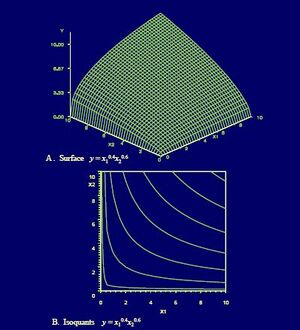Inada conditions
Topic: Finance
 From HandWiki - Reading time: 3 min
From HandWiki - Reading time: 3 min
In macroeconomics, the Inada conditions, named after Japanese economist Ken-Ichi Inada,[1] are assumptions about the shape of a function, usually applied to a production function or a utility function. When the production function of a neoclassical growth model satisfies the Inada conditions, then it guarantees the stability of an economic growth path. The conditions as such had been introduced by Hirofumi Uzawa.[2]
Statement
Given a continuously differentiable function
- the value of the function
- the function is concave on
- the limit of the first derivative is positive infinity as
- the limit of the first derivative is zero as
Consequences
The elasticity of substitution between goods is defined for the production function
In stochastic neoclassical growth model, if the production function does not satisfy the Inada condition at zero, any feasible path converges to zero with probability one provided that the shocks are sufficiently volatile.[6]
References
- ↑ Inada, Ken-Ichi (1963). "On a Two-Sector Model of Economic Growth: Comments and a Generalization". The Review of Economic Studies 30 (2): 119–127. doi:10.2307/2295809.
- ↑ Uzawa, H. (1963). "On a Two-Sector Model of Economic Growth II". The Review of Economic Studies 30 (2): 105–118. doi:10.2307/2295808.
- ↑ Takayama, Akira (1985). Mathematical Economics (2nd ed.). New York: Cambridge University Press. pp. 125–126. ISBN 0-521-31498-4. https://archive.org/details/mathematicalecon00taka.
- ↑ Barelli, Paulo; Pessoa, Samuel de Abreu (2003). "Inada Conditions Imply That Production Function Must Be Asymptotically Cobb–Douglas". Economics Letters 81 (3): 361–363. doi:10.1016/S0165-1765(03)00218-0.
- ↑ Litina, Anastasia; Palivos, Theodore (2008). "Do Inada conditions imply that production function must be asymptotically Cobb–Douglas? A comment". Economics Letters 99 (3): 498–499. doi:10.1016/j.econlet.2007.09.035.
- ↑ Kamihigashi, Takashi (2006). "Almost sure convergence to zero in stochastic growth models". Economic Theory 29 (1): 231–237. doi:10.1007/s00199-005-0006-1. https://www.rieb.kobe-u.ac.jp/academic/ra/dp/English/dp140.pdf.
Further reading
- Barro, Robert J.; Sala-i-Martin, Xavier (2004). Economic Growth (Second ed.). London: MIT Press. pp. 26–30. ISBN 0-262-02553-1. https://books.google.com/books?id=jD3ASoSQJ-AC&pg=PA26.
- Gandolfo, Giancarlo (1996). Economic Dynamics (Third ed.). Berlin: Springer. pp. 176–178. ISBN 3-540-60988-1. https://books.google.com/books?id=ouC6AAAAIAAJ&pg=PA176.
- Romer, David (2011). "The Solow Growth Model". Advanced Macroeconomics (Fourth ed.). New York: McGraw-Hill. pp. 6–48. ISBN 978-0-07-351137-5.
 |
29 views | Status: cached on August 25 2024 04:32:25
↧ Download this article as ZWI file
 KSF
KSF
